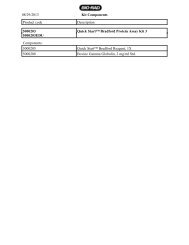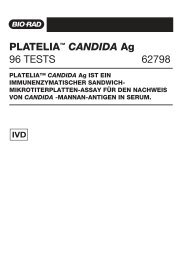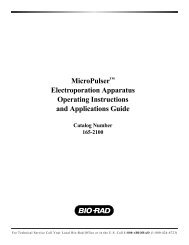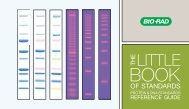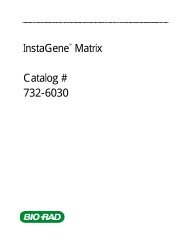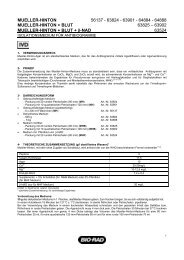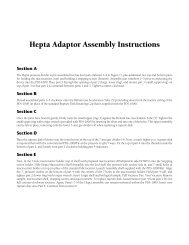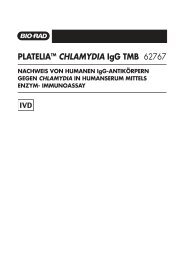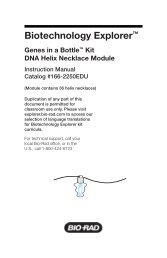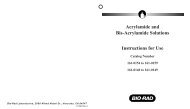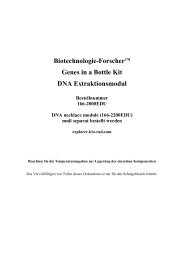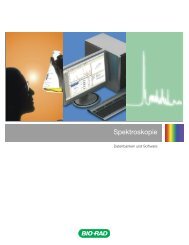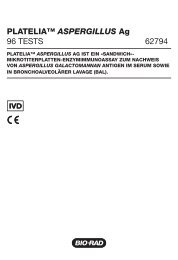Protein Expression and Purification Series - Bio-Rad
Protein Expression and Purification Series - Bio-Rad
Protein Expression and Purification Series - Bio-Rad
You also want an ePaper? Increase the reach of your titles
YUMPU automatically turns print PDFs into web optimized ePapers that Google loves.
<strong>Protein</strong> <strong>Expression</strong> <strong>and</strong> <strong>Purification</strong> <strong>Series</strong><br />
freezer is the least preferred method of lysing cells. When using the –20°C freezer method, it is<br />
imperative that the cell pellets are completely frozen to achieve lysis of the cells. If the resuspended cell<br />
paste is not completely frozen, adequate lysis will not occur.<br />
4. Separation of soluble <strong>and</strong> insoluble fractions<br />
A centrifuge capable of exerting 16,000 x g of force is necessary to separate the soluble <strong>and</strong> insoluble<br />
fractions. Since no DNase is used in this protocol, the insoluble fraction <strong>and</strong> genomic DNA tend to form a<br />
viscous blob rather than a defined pellet. Care is needed to not transfer the genomic DNA into the soluble<br />
fraction when separating the soluble <strong>and</strong> insoluble fractions.<br />
• Spin the lysate at 16,000 x g for 20 minutes. For a <strong>Bio</strong>-<strong>Rad</strong> Model 16K microcentrifuge, this is<br />
comparable to 14,000 rpm. For different instruments, please refer to the instrument's instruction<br />
manual <strong>and</strong> refer to Appendix C for help in determining the appropriate speed to use.<br />
• Extreme care is needed to not decant the insoluble fraction. If it is decanted into the soluble fraction,<br />
carefully try to separate the fractions again. If this is not possible the lysate can be centrifuged at<br />
16,000 x g for another 20 minutes to re-separate the fractions.<br />
• If genomic DNA carries over to the soluble fraction <strong>and</strong> is too viscous, the DNA can be sheared with a<br />
22 gauge needle to break it up for easier h<strong>and</strong>ling in subsequent steps.<br />
The figure below shows the insoluble <strong>and</strong> soluble fractions <strong>and</strong> the relative amounts of GST-DHFR-His<br />
found in each fraction.<br />
250 kD<br />
150<br />
100<br />
75<br />
50<br />
37<br />
25<br />
20<br />
15<br />
10<br />
5. Affinity purification—Centrifugation<br />
methodology<br />
A variable speed microcentrifuge is required for the affinity purification. It is critical to set the variable speed<br />
microcentrifuge so that it generates 1,000 x g of force. During the affinity purification, it is important to<br />
perform each step in the correct order.<br />
• For the <strong>Bio</strong>-<strong>Rad</strong> Model 16K microcentrifuge, 1,000 x g is equivalent to a speed of 3,500 rpm. A <strong>Bio</strong>-<br />
<strong>Rad</strong> mini-centrifuge should NOT be used since these produce 2,000 x g of centrifugal force which is<br />
too much for the Ni-IMAC resin to withst<strong>and</strong>.<br />
• Make sure to mix the slurry of Ni-IMAC resin fully to resuspend the chromatography beads.<br />
• It is extremely important to make sure that once the column is capped on both ends, that the resin<br />
<strong>and</strong> soluble fraction are thoroughly mixed before putting the column on a tube roller or rocking<br />
platform.<br />
Appendix A: Tips <strong>and</strong> Helpful Hints<br />
1 2 3 4 5<br />
Figure 2. Gel analysis of recombinant GST-DHFR-His<br />
expression <strong>and</strong> location of GST-DHFR-His after lysis.<br />
Lane 3 shows a strong b<strong>and</strong> of induced GST-DHFR-His<br />
expression (at arrow). Lanes 4 <strong>and</strong> 5 show comparable levels of<br />
GST-DHFR-His in the soluble <strong>and</strong> insoluble fractions. Lanes 4<br />
<strong>and</strong> 5 also have a prominent lower b<strong>and</strong> near 14 kDa. This is<br />
the b<strong>and</strong> for lysozyme (which is a good way of verifying that<br />
students added lysozyme to their samples).<br />
Lane Sample<br />
1 Precision Plus <strong>Protein</strong> Dual Color st<strong>and</strong>ards<br />
2 Uniduced cells<br />
3 Cells induced 4 hours<br />
4 Insoluble fraction<br />
5 Soluble fraction<br />
211<br />
APPENDIX A<br />
TIPS AND HELPFUL<br />
HINTS



